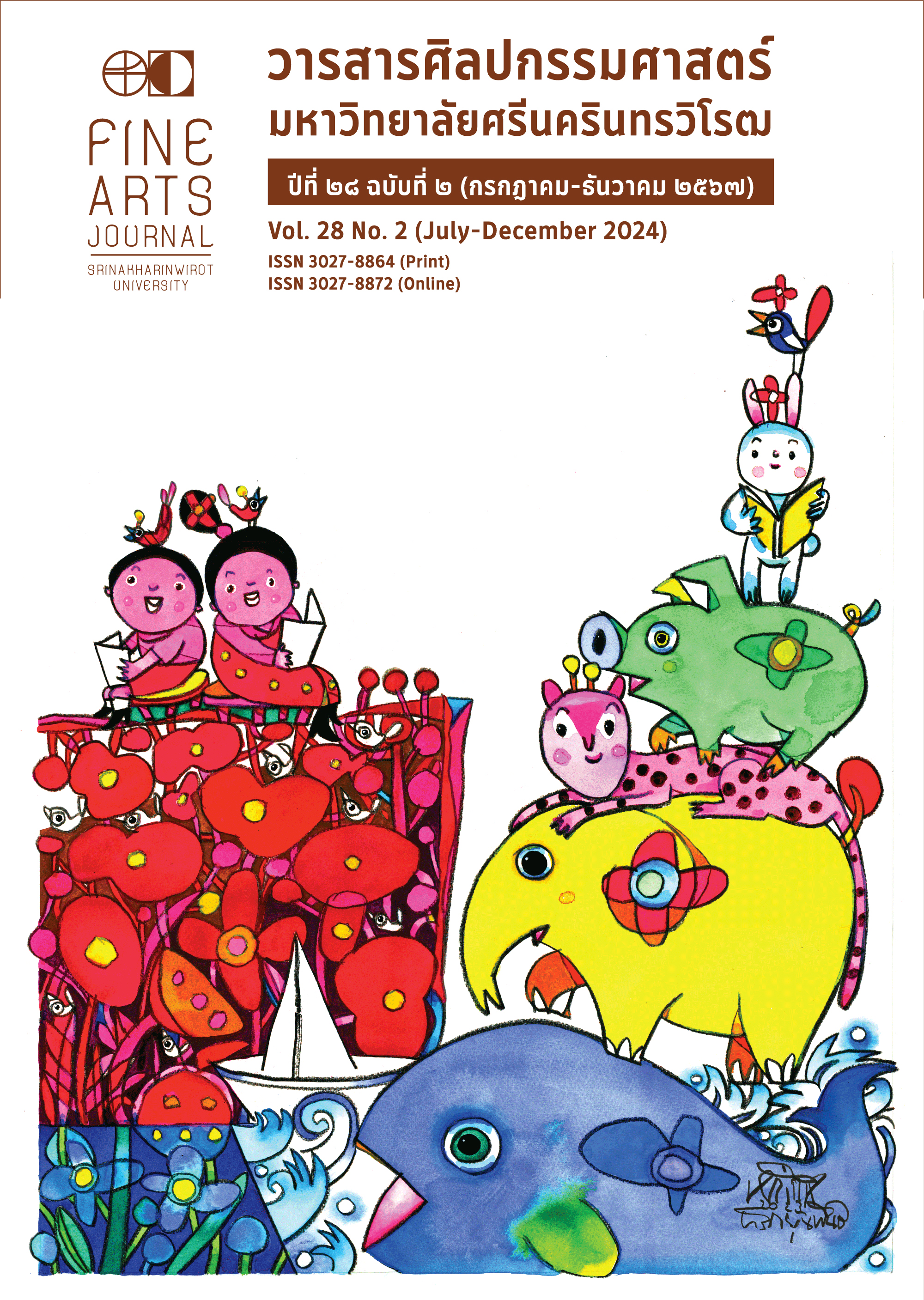ART TEACHING MODEL USING DESIGN THINKING AND CULTURAL CAPITAL FOR UNDERGRADUATE STUDENTS: A SYSTEMATIC REVIEW
Keywords:
Art Teaching Model, Undergraduate Students, Cultural Capital, Design thinking, Systematic ReviewAbstract
This study aims to analyze and synthesize the knowledge derived from research articles related to the art teaching model using design thinking and cultural capital for undergraduate students. The study involves a systematic review of research framework proposed by The Joanna Briggs Institute for Evidence-Based Nursing & Midwifery. The selection criteria are as follows: 1) research reports based on the art teaching model using design thinking and cultural capital for undergraduate students from domestic (Thailand) and international databases; 2) published research articles within a 5-year period from 2018 to 2022; 3) research articles specifically related to the art teaching model using design thinking and cultural capital for undergraduate students. The articles were screened according to the specified criteria and then synthesized and interpreted. The findings indicate that the art teaching model based on design thinking combined with cultural capital for undergraduate students encompass four key dimensions as follows: 1 Activity Dimension, which includes three types: 1.1 Classroom teaching, 1.2 Outdoor Education, 1.3 Blended Learning; 2) Instructional Media Dimension, which includes four types: 2.1 Material-based Media, 2.2 Computer-based Media, 2.3 Human-based Media, 2.4 Technical Method-based Media; 3) Evaluation Dimension, which consists of three approaches: 3.1 Instructors as assessors, 3.2 Target groups as assessors, 3.3 Target group representatives, community members, and experts as assessors; 4) Application Dimension, emphasizing the need for teaching approaches that encourage students to create social innovations.
References
ก่อเกียรติ ขวัญสกุล. (2564). การบูรณาการจัดการเรียนรู้ด้วยกระบวนการคิดเชิงออกแบบเพื่อพัฒนา
นวัตกรรมสื่อโครงการชุมชนท่องเที่ยวโอทอปนวัตวิถี บ้านวังยาว ตําบลเกิ้ง อําเภอเมือง จังหวัดมหาสารคาม. วารสารศึกษาศาสตร์ มหาวิทยาลัยสงขลา
นครินทร์ วิทยาเขตปัตตานี, 32(1), 164-184. สืบค้นเมื่อ 15 เมษายน 2566 จาก https://so02.tci-thaijo.org/index.php/ed
upsu/article/view/239381/168082
กรมส่งเสริมอุตสาหกรรม. (2559). ทุนทางวัฒนธรรม 9 ยุคสมัย. อุตสาหกรรมสาร, (58), 6. สืบค้นเมื่อ 28 เมษายน 2566 จาก https://e-
journal.dip.go.th/dip/images/ejournal/fd2eaa1aed d740f4b4e32346220a000d.pdf
คณะกรรมการมาตรฐานการอุดมศึกษา เรื่อง เกณฑ์มาตรฐานหลักสูตรระดับปริญญาตรี พ.ศ. 2565. (2565, 9 กันยายน). ราชกิจจานุเบกษา (เล่ม 139 ตอนพิเศษ
, น. 11-20).
ณชก หล่อสมบูรณ์, ปุณณรัตน์ พิชญไพบูลย์ และโสมฉาย บุญญานันต์. (2563). กระบวนการคิด
เชิงออกแบบในระบบการศึกษาสู่นวัตกรรมการสอนศิลปะ. วารสารศึกษาศาสตร์ มหาวิทยาลัยบูรพา, 31(2), 1-11. สืบค้นเมื่อ 18 สิงหาคม 2566 จาก
https://so02.tci-thaijo.org/index.php/edubuu/article/view/244347/165615
พชร วงชัยวรรณ์. (2565). การพัฒนานวัตกรรมการสอนการออกแบบผลิตภัณฑ์ชุมชน โดยใช้อัตลักษณ์จิตรกรรมฝาผนัง “ฮูปแต้มอีสาน” สำหรับนักศึกษาระดับ
ปริญญาตรี (วิทยานิพนธ์ปริญญามหาบัณฑิต). จุฬาลงกรณ์มหาวิทยาลัย, กรุงเทพมหานคร. สืบค้นเมื่อ 8 เมษายน 2566
จากhttp://cuir.car.chula.ac.th/handle/123456789/81711
พลเดช เชาวรัตน์, มลฤดี เชาวรัตน์, ดาราลัย ไซมะเริง, กิ่งกาญจน์ โสภณพิศุตม์, ลินจง โพชารี, ศมลวรรณ
วรกาญจน์, ธเนศ ฉัตรจุฑามณี, อิสสระ ดวงเกตุ, สรัญญา ภักดีสุวรรณ, อมฤต สมพงษ์, ญาดา สามารถ และธราธร บุ้งทอง. (2565). การประยุกต์ใช้
กระบวนการคิดเชิงออกแบบในการออกแบบวิดีทัศน์มรดกทางวัฒนธรรมชุมชนแกดำ จังหวัดมหาสารคาม. วารสารสถาปัตยกรรม การออกแบบและการ
ก่อสร้าง คณะสถาปัตยกรรมศาสตร์ ผังเมืองและนฤมิตศิลป์ มหาวิทยาลัยมหาสารคาม, 4(1), 13-24. สืบค้นเมื่อ 15 เมษายน 2566 จาก
https://so02.tci-thaijo.org/index.php/Jadc/article/view/254402/171961
ภุชงค์ โรจน์แสงรัตน์. (2559). การพัฒนารูปแบบการสอนโดยใช้การคิดเชิงออกแบบเป็นฐานเพื่อสร้างสรรค์ผลงานที่ปรากฏอัตลักษณ์ไทยสำหรับนิสิตนักศึกษา
ระดับปริญญาบัณฑิต. (วิทยานิพนธ์ปริญญาดุษฎีบัณฑิต). จุฬาลงกรณ์มหาวิทยาลัย, กรุงเทพมหานคร. สืบค้นเมื่อ 15 เมษายน 2566 จาก
http://cuir.car.chula.ac.th/handle/123456789/54891
ภุชงค์ โรจน์แสงรัตน์, ปุณณรัตน์ พิชญไพบูลย์ และปราวีณยา สุวรรณณัฐโชติ. (2563). การพัฒนารูปแบบการสอนโดยใช้แนวคิดการคิดเชิงออกแบบเป็นฐานเพื่อ
สร้างสรรค์ผลงานที่ปรากฏอัตลักษณ์ไทยสำหรับนิสิตนักศึกษาระดับปริญญาบัณฑิต. วารสารครุศาสตร์ จุฬาลงกรณ์มหาวิทยาลัย, 48(3), 258-273.
สืบค้นเมื่อ 15 เมษายน 2566 จาก https://so02.tci-thaijo.org/index.php/EDUCU/article/view/245006/165935
ศูนย์สร้างสรรค์งานออกแบบ (TCDC). (2560). การคิดเชิงออกแบบ: เรียนรู้ด้วยการลงมือทำ.
กรุงเทพมหานคร. สืบค้นเมื่อ 8 เมษายน 2566 จาก http://resource.tcdc.or.th/ebook/ Design.Thingking.Learning.by.Doing.pdf
สำนักงานเลขานุการของคณะกรรมการยุทธศาสตร์ชาติ สำนักงานคณะกรรมการพัฒนาการเศรษฐกิจ
และสังคมแห่งชาติ. (2561). ยุทธศาสตร์แห่งชาติ พ.ศ. 2561-2580 (ฉบับย่อ). สืบค้นเมื่อ
เมษายน 2566 จาก https://www.nesdc.go.th/download/document/SAC/NS_ SumPlanOct2018.pdf
สุภรพรรณ คนเฉียบ และมิ่งขวัญ กันจินะ. (2563). ผลการประเมินตนเองด้านทักษะการเรียนรู้และ
นวัตกรรมของนักศึกษาไทยที่เข้าร่วมกิจกรรมการคิดเชิงออกแบบเพื่อนวัตกรรมทางสังคม.
วารสารการพัฒนาชุมชนและคุณภาพชีวิต, 8(2), 327-338. สืบค้นเมื่อ 30 เมษายน 2566
จาก https://so02.tci-thaijo.org/index.php/JCDLQ/article/view/244740/165822
อัจฉรา คำมะทิตย์ และมัลลิกา มากรัตน์. (2559). การทบทวนวรรณกรรมอย่างเป็นระบบ: วิธีปฏิบัติทีละขั้นตอน. วารสารเครือข่ายวิทยาลัยพยาบาลและการ
สาธารณสุขภาคใต้, 3(3), 246-259. สืบค้นเมื่อ 18 สิงหาคม 2566 จาก https://he01.tci-thaijo.org/index.php/scnet/article/
view/68742/55965
Manna, V., Rombach, M., Dean, D., & Rennie, H. G. (2022). A Design Thinking Approach to Teaching Sustainability. Journal of Marketing
Education, 44(3), 362-374. Retrieved 8 April, 2023, from https://journals-sagepub-com.chula.idm.oclc.org/
doi/epub/10.1177/02734753211068865
Najla, M. (2018). Engaging College Students in the Transition to Sustainability Through Design-Based Approaches. Consilience: The
Journal of Sustainable Development, 20(1), 88-103. Retrieved 9 April, 2023, from https://www.jstor.org/stable/26760104
Pearson, A., Field, J., & Jordan, Z. (2007). Evidence-based clinical practice in nursing
and health care: Assimilating research, experience, and expertise. Oxford: Blackwell.
Rukpium, P. (2022, June 2). CU Social Innovation Hub – Driving Social Science
Research towards Social Innovation, Raising the Community’s Quality of Life,
Meeting Social Needs. Retrieved 9 April, 2023, fromhttps://www.chula.ac.th/en/highlight/74830/
Downloads
Published
How to Cite
Issue
Section
License

This work is licensed under a Creative Commons Attribution-NonCommercial-NoDerivatives 4.0 International License.





